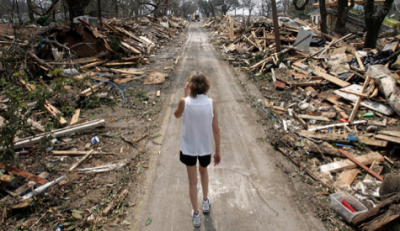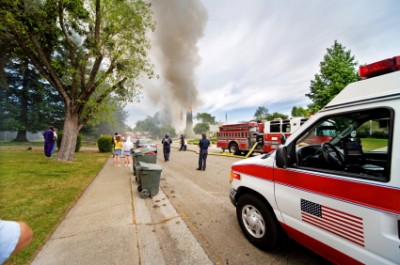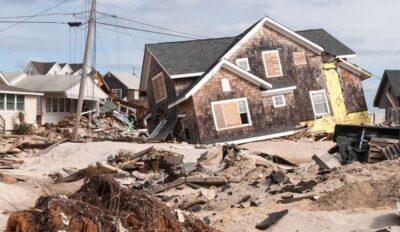Whether you live in a little farm town that sits on the edge of nowhere, or your humble homestead is an apartment somewhere in a concrete jungle, all regions face some sort of crisis event risk.
But what do I mean by the term “crisis event risk”?
Well, essentially, it’s the threat level and itemization of unique risks that each locality/community/municipality faces, which could potentially cause mass chaos and disruption on a regional level.
These event risks come in all shapes, sizes and severities. And that means that it’s up to us to figure out what bad things might happen to our region someday. And if such bad things were to occur, then you’ll already have been a step ahead of the game when it all goes down.
Let’s Deal With the Obvious
When making crisis event risk assessments of a particular region, it’s best to gauge your preparations (for bugging-in or bugging-out) based on an imminence-to-severity ratio. At the same time, it’s also important to keep a weather eye out for the obvious stuff that lots and lots of people have historically been talking about.
Even though freak events can occur, certain regional populations are far too aware and locally invested NOT to take such well-known crises seriously. For instance, if you were living in or near the San Francisco Bay Area, then it’s no secret that “The Big One” is headed your way … and you don’t have to be a prepper to admit that fact.
Especially in the case of the San Andreas, there won’t be too many winners when that fault decides to do a tap dance all over the West Coast. Hence, this is why millions of dollars have been spent on figuring out what it will do to the region and how best to predict/prepare for it.
Thus, if you’re living by the Gulf of Mexico, then you should probably prepare for hurricanes before getting ready for a potential amphibious land invasion of Cuban zombies.
And What About the Not-So-Obvious?
 Speaking of land invasions, it would be erroneous to believe that the US has never been marked for a hostile takeover by foreign militaries. In fact, both Japan and Germany had the mainland of the US sighted in for putting their boots on American soil during World War II. And even though it was two centuries ago, the War of 1812 WAS a land invasion of the US.
Speaking of land invasions, it would be erroneous to believe that the US has never been marked for a hostile takeover by foreign militaries. In fact, both Japan and Germany had the mainland of the US sighted in for putting their boots on American soil during World War II. And even though it was two centuries ago, the War of 1812 WAS a land invasion of the US.
So, if we were to think of a crisis event risk of foreign invaders on “flood terms,” then you might say that the invasion would be like a “200-year crisis event risk.” While it might not occur in our lifetime, it would cause unfathomable disruption in comparison to, say, a hurricane. Hurricanes are rather predictable; they tend to meander this way every year, and they don’t come to usurp our government and constitutional liberties using tanks, troops and torpedoes.
But, of course, then there are those risks that are several centuries and millennia in the making. Many academic and government geological gurus have their eye on the Yellowstone caldera these days. Yet at the same time, THAT particular volcanic flower hasn’t bloomed for thousands of years. Why are people so dern concerned about that puppy going off?
Well, quite frankly, it’s not a foregone conclusion to suspect that if it does, then congratulations, world, it looks like global famine for a decade or two. As for the US, we’ll be covered under a foot of ash … and that region of the Northwest probably will be known as “Yellowstone National Crater.”
The point here is simple: perspective.
The Simple Event Risk Point Scale (SERPS)
When determining just how to prioritize your preparedness when applying that crisis event risk ratio of imminence vs. severity, my advice is to assign a 1-to-10-scaled point value to the events in question. So first, list the possible events of your concern, and then give each an imminence and severity number. For instance, if you live in northern Pennsylvania …
Winter Season With Abnormally Massive Blizzards:
- Imminence – 5 (Lake-effect snowstorms happen fairly regularly each winter.)
- Severity – 2 (While this might cause a slight setback, the region is already quite prepared.)
6.5 Earthquake:
- Imminence – 1 (Not many are even aware that severe earthquakes are possible near Appalachia, and such an event would be rather unlikely.)
- Severity – 8 (The unlikeliness of the event would become the cause of the most destruction inflicted. Only a handful of properties would be structurally prepared for an earthquake, thereby resulting in absolute chaos and perhaps billions of dollars in damages.)
Truthfully, these point values are largely going to be based on your own intuition and research. However, they will provide an excellent marker for you to at least quantify your concerns.
The Latest Breakthrough Advancement In Solar Backup Generators Is Here!
No, it might not exactly be a perfect system, but it will still help you move forward on your preps in a logical, strategic manner.
Regional Risk Boosters
 There are two major issues that should have a HUGE influence on your crisis event risk assessment. Not only will these factors have a profound influence on your ability to bug out, but they will even make bugging in more dangerous as well. Hint: These are the same reasons why there’s such a thing called “rush hour.”
There are two major issues that should have a HUGE influence on your crisis event risk assessment. Not only will these factors have a profound influence on your ability to bug out, but they will even make bugging in more dangerous as well. Hint: These are the same reasons why there’s such a thing called “rush hour.”
- Population Density – This factor alone makes city survival a very difficult task, especially during a crisis event. Most people in the city will not be prepared like an off-the-gridder, and desperation has a way of exhibiting the worst parts of human nature. Not only that, but people need similar resources, and those resources will dry up quickly when regional economic supply chains are cut.
- Barriers n’ Bottlenecks – With high population densities often comes a mass exodus from the affected region during a crisis. As I said about “rush hour,” movement will crawl, and then, come to a bumper-to-bumper stop in places where the evacuation flow becomes concentrated into a bottleneck. Barriers, such as mountains, rivers and oceans, tend to have this effect, so make sure that you plan around them.
Because Tsunamis Are Bulletproof
When making your risk assessments, be sure to factor these two pointers into your strategy. And even if you don’t necessarily live near a densely populated area, it’s still important to account for a nearby city or large town that could send those populations in your direction. That’s why a major interstate onramp might be a fast track today, but a crisis event could turn it into a parking lot of fuel-less automobiles within just hours.
Having a strategic, unbiased and logical look at your area’s crisis event risk could mean the difference between a successful bugout and a tragic one, because a white picket fence is not a defensive option, and a loaded AK-47 won’t help you survive an incoming tsunami.
How do you gauge your area’s crisis event risk? Share your suggestions in the section below:
Be Prepared When There’s A Blackout In Your Region. Read More Here.
 Off The Grid News Better Ideas For Off The Grid Living
Off The Grid News Better Ideas For Off The Grid Living




